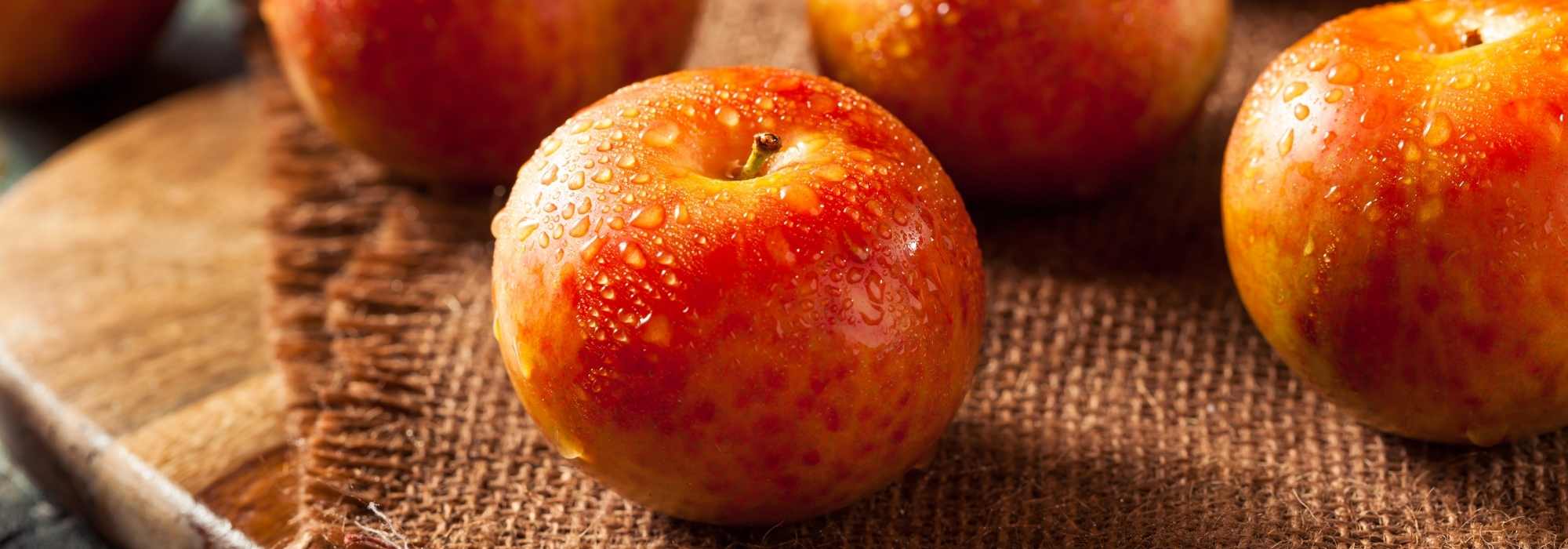
Pluot : planting, cultivation, harvest
Contents
Pluot in a nutshell
- It is a hybrid fruit, part plum and part apricot
- As big as a peach, the pluot tastes like an apricot
- Its flesh is very sweet, juicy, and fragrant
- The harvest takes place from June to August
- Easy to grow, very hardy, this fruit tree thrives in the sun in light, well-draining soil
A word from our expert
The pluot, also known as “apricot-plum”, “plumcot”, or “dinosaur egg”, is a hybrid fruit tree that produces fruits that are part plum, part apricot. This interspecific species has been making its way to our markets for a few years now. It produces large fruits in summer, about the size of peaches, with a melting, very sweet flesh and a flavour reminiscent of apricot.
It is a semi-dwarf tree that will not exceed approximately 3.50 m in height when mature, making it ideal for small gardens.
Perfectly hardy, the Pluot thrives in full sun, sheltered from the wind, in light, well-drained soil without excess moisture. It is not very demanding; simply water it during the summer in the first few years and prune it annually to enjoy bountiful harvests.
The pluot is best enjoyed fresh, just picked, in fruit salads, as well as in pastries and jams.
Discover our tips for cultivating this generous fruit tree!
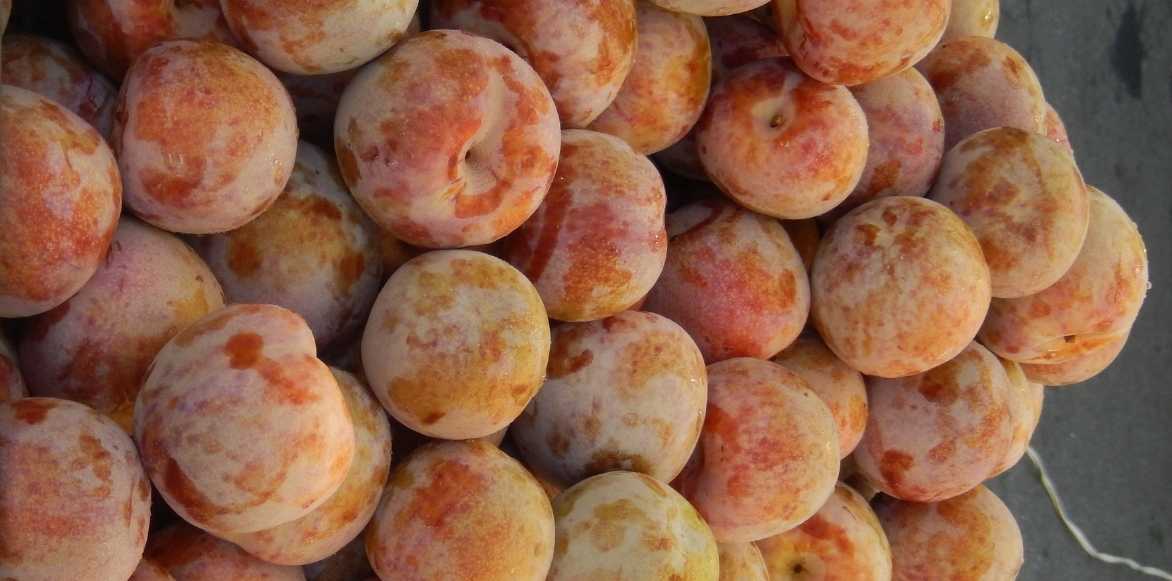
Pluots
Description and Botany
Botanical data
- Latin name Pluot
- Family Rosaceae
- Common name Pluot, apricot-plum
- Flowering March-April
- Height 2 to 3.50 m
- Exposure Sun
- Soil type Rich, light, well-drained
- Hardiness -35 °C
The pluot, also known as “apricot-plum”, “plumcot”, or “dinosaur egg”, is a fruit tree belonging to the rose family, just like the apricot tree, almond tree, and peach tree. It is an interspecific species, a new hybrid fruit, resulting from the cross-breeding of a plum (Prunus domestica at 70%) and an apricot (Prunus armeniaca at 30%). Its hybridization was developed in 1988 in the United States by Chris Floyd Zaiger, a Californian breeder and developer of stone fruit varieties. Pluot® is now a registered trademark. Today, it is available in about 25 hybrid varieties such as ‘Flavor Candy‘ and ‘Flavor Supreme’, which was the first Pluot® variety introduced to the market.
The pluot forms a semi-dwarf tree with an open habit that will not exceed 3.50 m in height when mature. This makes it an interesting fruit tree for small gardens. The silhouette is naturally spreading. The branches bear deciduous foliage. Like the plum tree, the branches of the pluot are quite brittle under the weight of the fruit. The leaves are long, ovate, measuring 8 to 15 cm long and 3 to 4 cm wide, with a short petiole. Bright green in color, they are smooth and have crenate margins.
Flowering occurs in March-April on the previous year’s branches. The pluot is then covered with small pale pink flowers typical of the rose family, which are cup-shaped and composed of 5 sepals and 5 pedunculate petals. The flowers are hermaphroditic. Most varieties are self-fertile (Pluot® Pink Candy®, Pluot® Pink Candy®, Pluot® Purple Candy®), so it is not necessary to have another apricot or plum tree nearby for good fruiting. Self-sterile varieties will fruit better with cross-pollination by planting a plum tree nearby to enhance fertility.
Once pollinated by bees, the flowers transform into large fruits; the Pluots. They are harvested from June to August depending on the regions. With their smooth skin, Pluots closely resemble plums, but their size is more akin to peaches. The fruits are round, about the size of peaches at approximately 6 cm in diameter, and have retained the small crease typical of apricots. The epidermis is thin, its color varies from dark purple to pink-red, and it is sometimes bicolored and punctate with colored spots. They are most often covered with a bloom that disappears upon touch. They contain juicy, sweet flesh, either yellow or red, very fragrant, with a tangy flavor and texture similar to that of apricots. Generally, it takes about 3 years before the first harvest.
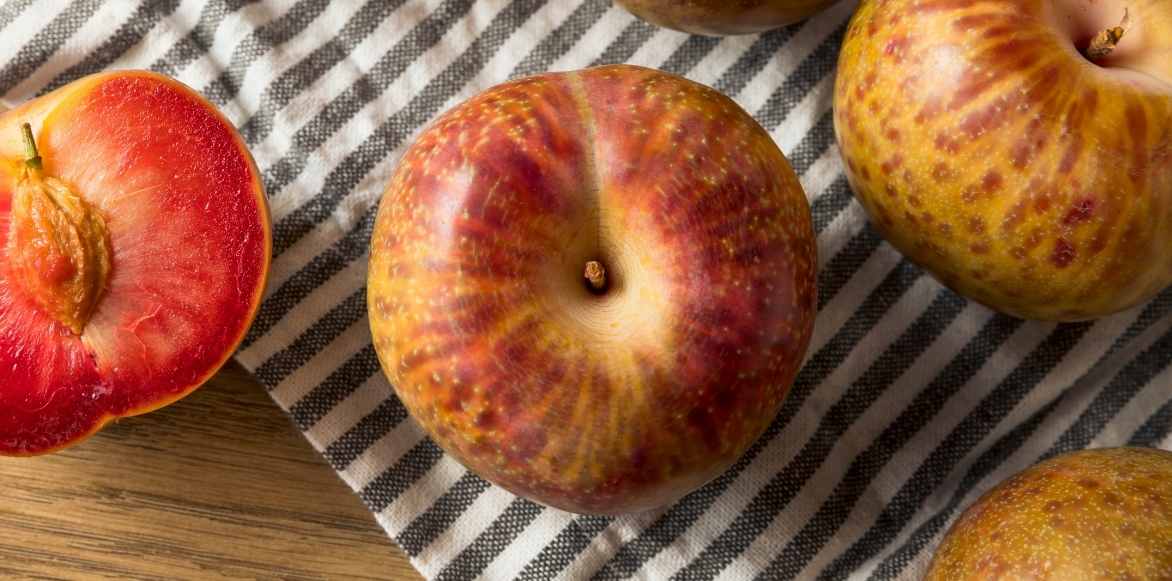 The pluot is a hybrid between plum and apricot
The pluot is a hybrid between plum and apricotMain varieties
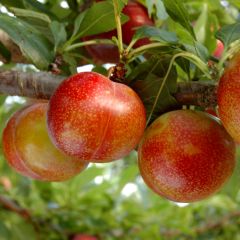
Pluot Flavor Candy - Plumcot
- Flowering time May, June
- Height at maturity 2,50 m
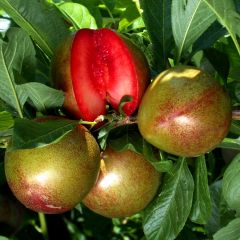
Pluot Flavor Supreme - Plumcot
- Flowering time April
- Height at maturity 3,50 m
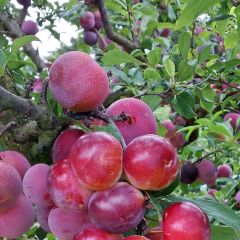
Pluot Pink Candy - Plumcot
- Flowering time May
- Height at maturity 2,50 m
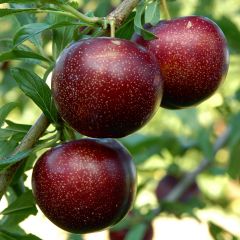
Pluot Purple Candy - Plumcot
- Flowering time May
- Height at maturity 2,50 m
Discover other Pluot trees
View all →
Available in 2 sizes

Available in 2 sizes

Available in 2 sizes

Available in 2 sizes
Young plantation
Where to plant it?
Perfectly hardy, the pluot can withstand temperatures as low as -35 °C, allowing it to be planted in all regions. Preferably install it sheltered from north and east winds in the coldest areas to protect the flowering.
To ensure it produces beautiful fruits, plant it in full sun in neutral, light, deep, and well-drained soil, without excess water. It dislikes heavy and compact soils.
As it maintains modest proportions, it is a fruit tree well-suited for small gardens. It can be planted within an orchard, but also in an ornamental garden, where it will brighten up with its beautiful spring flowering. Self-sterile varieties require the planting of another plum tree (’Golden Japan’, for example) or apricot tree nearby to bear fruit.
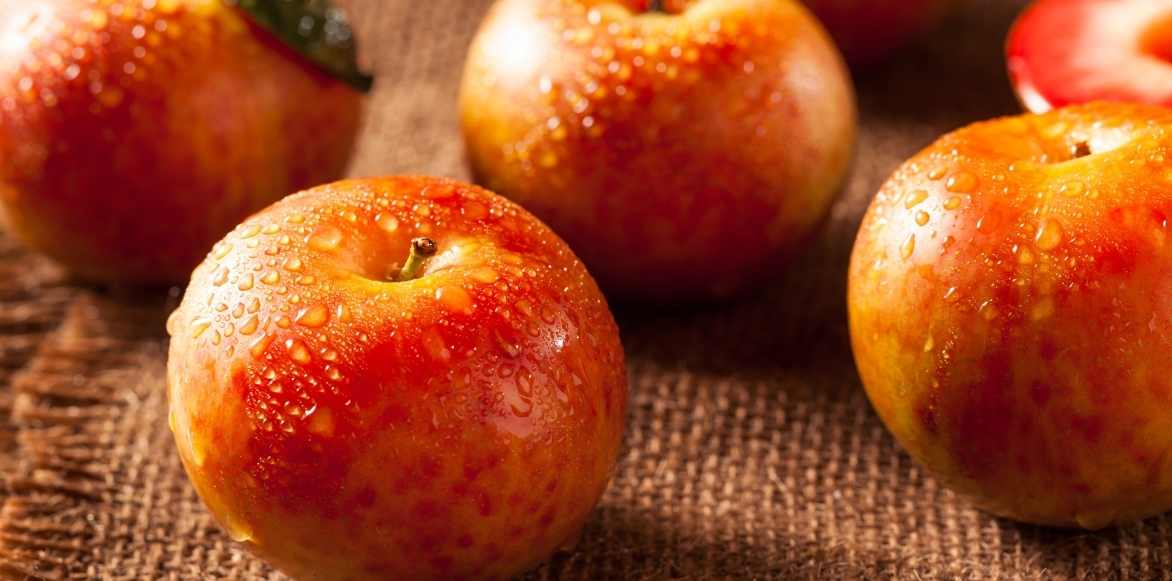
Pluots
When to plant?
Generally offered bare-root, the pluot is preferably planted from October to December, outside of frost periods.
How to plant?
- Dig a hole two to three times wider and deeper than the root ball
- Moisten the root ball by placing it in a basin of water for a few minutes
- Spread gravel at the bottom of the planting hole
- Add compost
- Place the pluot at the bottom of the hole
- Set the tree in the hole and fill in, gently compacting as you go to remove air pockets with enriched garden soil mixed with potting soil
- Water abundantly and regularly to help your pluot settle in
Caring for and pruning Pluot
After planting, for the first three years, ensure regular watering, as the soil must remain cool throughout the summer. It prefers soils that retain a bit of moisture. In autumn or spring, apply manure by scratching the surface, or use fertiliser for fruit trees.
Remove the shoots that have grown at the base of the tree.
The apricot-plum is a fruit tree resistant to fungal diseases and pest attacks.
When and how to prune?
Proper pruning leads to good fruiting.
Training pruning
This is carried out in the spring following planting, outside of frost periods, and for the next three years before the tree becomes productive. Use a saw or a pruning shear. It involves pruning to remove poorly placed and weak branches, retaining only five branches that will form the framework of the tree. This training pruning is necessary in the early years.
Fruiting pruning
Fruits appear on one-year-old wood, and branches that have borne fruit will not produce more pluots. This pruning encourages good fruit production and is carried out in winter with a well-sharpened and carefully cleaned pruning shear. Seal the pruning wounds with a healing paste to prevent diseases. It is advisable to:
- Prune branches that have already borne fruit to two buds above the future branching
- Remove the suckers that develop on the trunk
- Eliminate dead or broken wood and crossing branches
- Shorten the longest branches
Multiplication
The Pluot reproduces by grafting, a technique that requires a certain level of skill more suited to professional gardeners. It is also possible to take the suckers that develop around the mother plant and replant them further away, but they will only flower many years after planting.
When and how to harvest pluots?
Harvest takes place at ripeness from June to August-September depending on the varieties and regions. Fruits are simply harvested by hand when they are tender to the touch.
Usage and conservation
Apricots-plums can be eaten raw or prepared. They are best enjoyed fresh, immediately after picking. Pluots are also delicious in fruit salads, clafoutis, cakes, crumbles, or tarts. They can also accompany savoury dishes. They can be made into jams, fruit in syrup, compotes, or juices.
They do not keep for long, only a few days at room temperature. Once washed, dried, and pitted, they can be frozen.
A pluot contains about 80 calories. The flesh is rich in vitamins C and A, trace elements (potassium), and fibre.
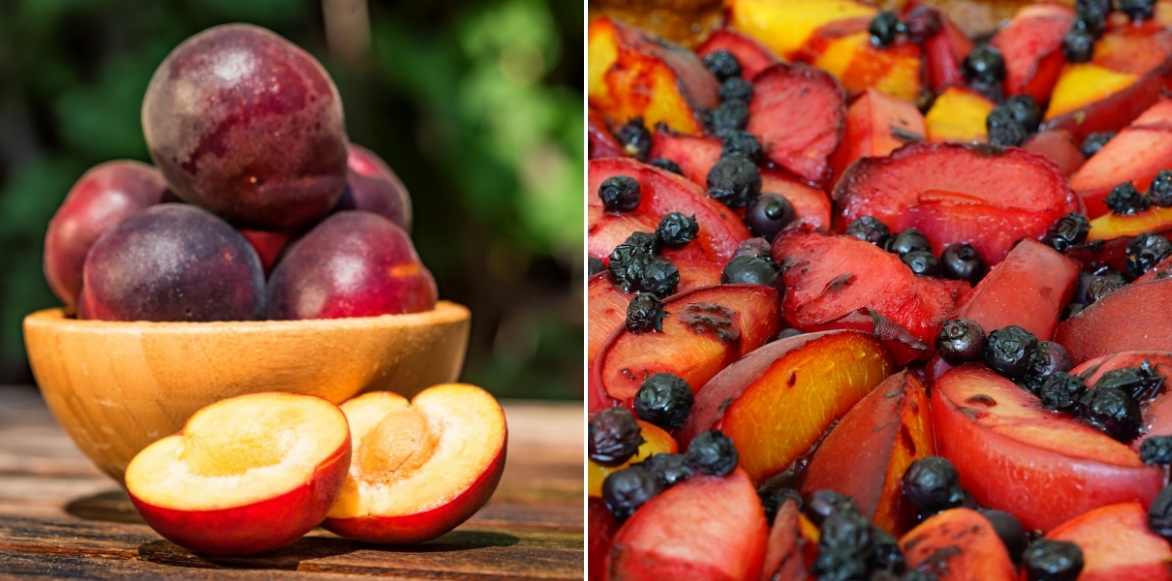
The pluot can be eaten raw or cooked in tarts or clafoutis, for example
Useful resources
- Discover all our tips for properly cultivating, protecting, and maintaining your fruit trees
- Sow a flower meadow at the foot of your fruit trees and nature will reward you
- Our video: How to prevent birds from eating our fruits?
- Subscribe!
- Contents































Comments